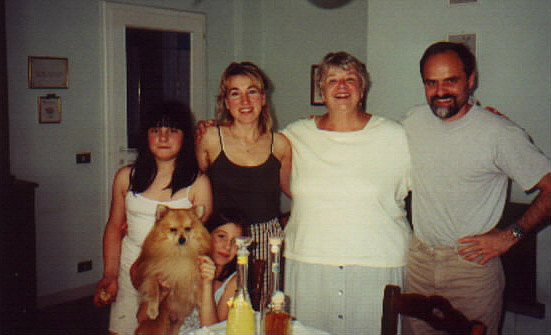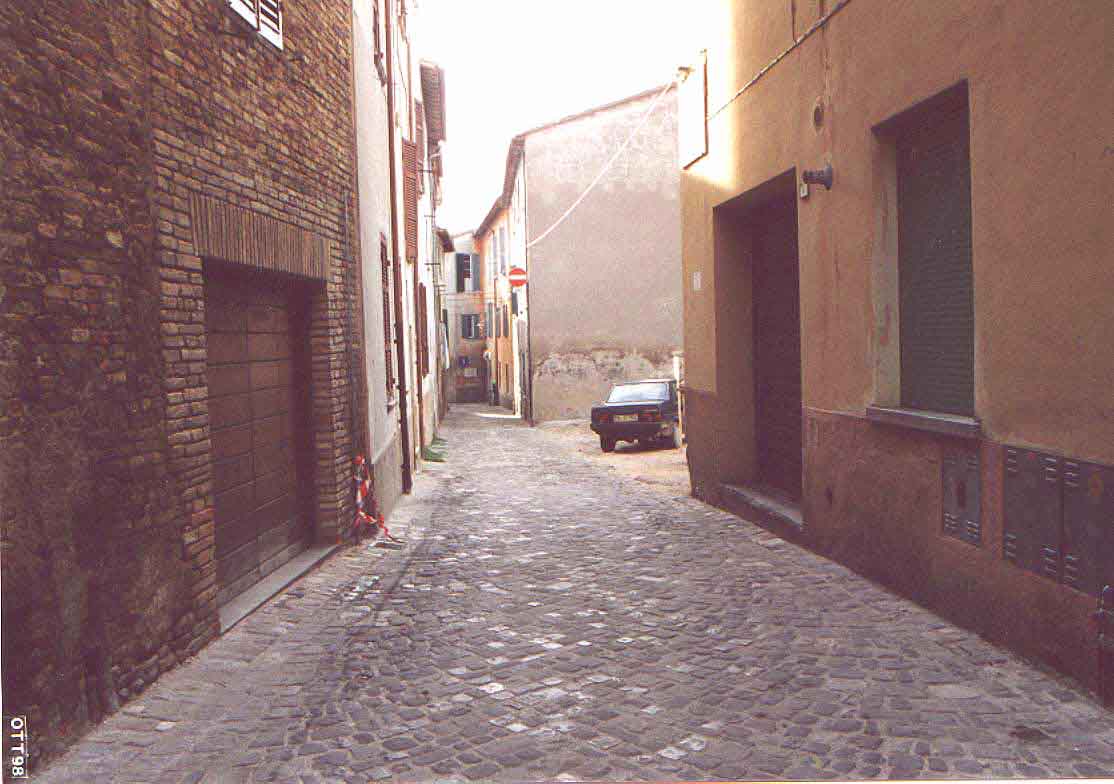| Deborah Stott | Letter from Urbania, 17 October 1998 | |
|
Golly, rescued
Friends
My street
|
First of all, the cat is fine. In fact, she now has much better digs than I have. I believe I sent you all the story of my rescue and since then, all anyone has asked me is how is the cat. She was adopted by a woman at the Centro Studi Italiani, the Italian language school from which I am renting my apartment, and she turned out to be an Englishwoman married to the director of the school. At her invitation, I went yesterday to visit the cat, now named "Golly," as in golliwog, English English for pollywog and in Italian pronounced somewhere between "goalie" (as in hockey) and "golly." She is all black and the name fits beautifully. Her new home is about six kilometers out of Urbania in the mountains and is a carefully and beautifully restored farmhouse surrounded by mountains, trees, and rosebushes. There are three other cats and a couple of dogs and six teenagers, the youngest of whom is now devoted to Golly and carries her around whenever she is home, much to the catís delight. She cleaned up really well and has a lovely black long furry coat and is just adorable. The other cats were diffident at first, as cats can be, but they have now accepted her and even bathe her. I doubt she remembered me as her savior but she purred gratifyingly when I held her. Iím down to my last two weeks here and feeling the pressure of still so much to do and so little time. I really donít think Iíve ever worked this hard and this concentratedly on anything before - though the concentration is beginning to fray a bit, after six straight weeks of 7+ hour days trying to read the handwriting and the Latin. I have a three-inch high pile of xeroxes, some double-sided, of documents that I must try to read in detail and probably translate. I also have many pages of my own notes on other items that are important and of interest. The chronology that I started last summer, an attempt to put all the stuff Iíve looked at, including the letters, in chronological order, is now over 55 pages. Iíve finished with the notariesí books, at least for now, and am starting on other material in the archives. This is less orderly and much more spotty than the notarial books and is kept in numbered boxes. These seem to contain a variety of stuff and, fortunately, there is an old listing of the contents, so I can at least get an idea of whatís there. There are lots of "atti civili," the records of civil actions of various kinds, mostly, as far as I can tell, overseen by the notaries. This is presumably what they were doing when they werenít sitting around authorizing contracts and such. There is also a small number of "atti criminali," criminal cases, and some other stuff. As I say, itís very spotty and there donít seem to be any long runs of any one thing. But Iíve tried to identify some key periods in Corneliaís story and Iíll look particularly for those years or periods of time. There are also some censuses, though here again, they seem to be pretty spotty for the earlier periods. In any case, there is still a lot of material to go through and precious little time and Iím back to waking up at 5 or 6 in the morning worrying. Donít get me wrong - this is actually fun and Iím going to really miss it when I leave. For one thing, itís very specific and for another, as Iíve said before, itís a real kick to get to know the people and events of the past. Much as Iíve tried to avoid doing this, Iíve formed pictures of some of the key players on the basis of their actions, but of course I must try to avoid drawing unwarranted conclusions. Last Monday, I made the hourís drive to Pesaro, which is the capital city of this province and is home to its branch of the state archives, in order to try to trace something of the activity there of Corneliaís second husband. I was unsuccessful in this, though I did find some notarial volumes of notaries from Urbania and a few more notations about Cornelia. But it turns out I have to go back there this Monday to look for two letters that the Duke of Urbino wrote to Cornelia asking her to send him two paintings after drawings by Michelangelo. In the book written by Corrado Leonardi, he included transcriptions of these letters and noted that they were in Urbino. But when we called Urbino, we were told that all the older material has been transferred to the Archivio di Stato in Pesaro. If I can find them, I really want to see them for myself. OK, now for some local color. Today and tomorrow Urbania is holding one of its biggest events of the year, the Fiera delle donne, or Womenís Fair. The name and the event, Laura tells me, come from earlier days when agricultural communities had their lull times in mid-October, after harvesting and before planting. This was a good time for houses to be put in order and trousseaux to be assembled, so it was the perfect time for a big market fair. So the whole town, literally the whole town, is taken up today and tomorrow with stalls selling everything from undershirts to bonsai plants. I havenít had a chance to go around to them all yet, but on my way home from the library for lunch, I did buy myself something I havenít had for more than 20 years - an undershirt. These little items, now pretty much lost to view in places like the U.S.A. where energy is cheap and (over)heating something one takes for granted, are indispensable when it starts to get chilly. I remember having them as a matter of course during the first years I lived in Italy and then they were all wool, wonderfully fine and soft and warm. The womenís varieties always had some nice pattern-work or lace and were really very pretty. The one I just got is a drop in quality - half-wool, half-cotton - and not quite as nice as I remember, but Iím sure it will help keep me warm. At the moment, anyway, thereís no heat in the library and it does get pretty chilly on occasion. There is, in fact, a potential heat source in the form of a hot water heater that sends hot water to radiators (the same sort of thing I have in my apartment), but whenever they turn it on the electricity goes out. So, for the foreseeable future, I think we have to make do with undershirts and layered clothing.
Sunday, 18 Oct. I had to break off writing and go back to the library yesterday afternoon, though it was a bit difficult to keep my mind on my work with all the street noise from the fair, not to speak of the smells of warm sugared nuts and roasting chestnuts that wafted in through the windows. So today, the last day of the fair, I made the circuit of everything and bought myself a warm nightgown - the last thing I discarded while packing last August was my nice warm bathrobe - and some sugared peanuts. At the risk of maudlin sentimentality, the market reminds me of those first years in a little town in Italy, where the weekly fair was a really big deal if you were living there. And for real excitement, you got in the car and went to the even bigger fair in a slightly larger town. Though it did strike me that not only have prices increased exponentially - thatís to be expected - but the relative prices here arenít particularly good. A little espresso coffee pot that Iíd seen for L.44,000 at the supermarket at Joyland was L.55,000 here! On the other hand, I was able to get an Italian version of a hot dog and fries for lunch. There were stalls and stalls and stalls of clothing and shoes - Iím told that shoe production is big in the Marches - including some nice leather jackets. Also lots of socks and underwear. As is clear from my schedule, Iím leading a life here fairly free of local color, but here is one observation. Right next to my apartment building is a little vacant lot where, when I first got here, several people parked cars, including me. One of the cars that was regularly there was rather elderly and somewhat the worse for wear. I noticed, however, that it wasnít beat-up all over but just at its four corners, which seemed odd. The bumpers front and back were bent and scraped at the ends and the side turning lights at the back were broken. A couple of weeks ago, I saw an elderly man putting up a "private property" sign there and gradually the cars disappeared, including mine, which I parked elsewhere, except for that one. It turns out, of course, that the elderly car and the elderly man go together. But a few days ago, I saw the explanation for the pattern of destruction on the car. As Iíve told you before, the streets here are very narrow - 10 to 12 feet would be my guess. So when you try to make a right-angle turn in a car, you can imagine that it calls for a certain amount of creative maneuvering. The other day I watched this gentleman make a left-hand turn into my street. He couldnít do it in one turn, obviously, so he drove until he had just bumped into the building on the opposite side of the street and then backed up for another try, hitting the building behind him in the process. This time he was almost able to make the turn cleanly, but not quite. Apparently it was good enough for him and he just continued on, brushing his fender against the building on his way. Hence his dented fenders. Iíll be moving down to Rome on 31 October and have mixed feelings about it. Iíve come to feel quite at home here - Anita suggested that they could just put a cot in the library for me - even though I havenít had the time to really get to know the area as Iíd hoped. Iíve collected a tremendous amount of material but I know that I really need more time to do a better job. On the other hand, I also do feel ready for a change, and I will especially welcome some more outside stimulation: in short, Rome. But I will give up the immersion in small-town Italian life that Iíve had here, which has its own pleasures. |



